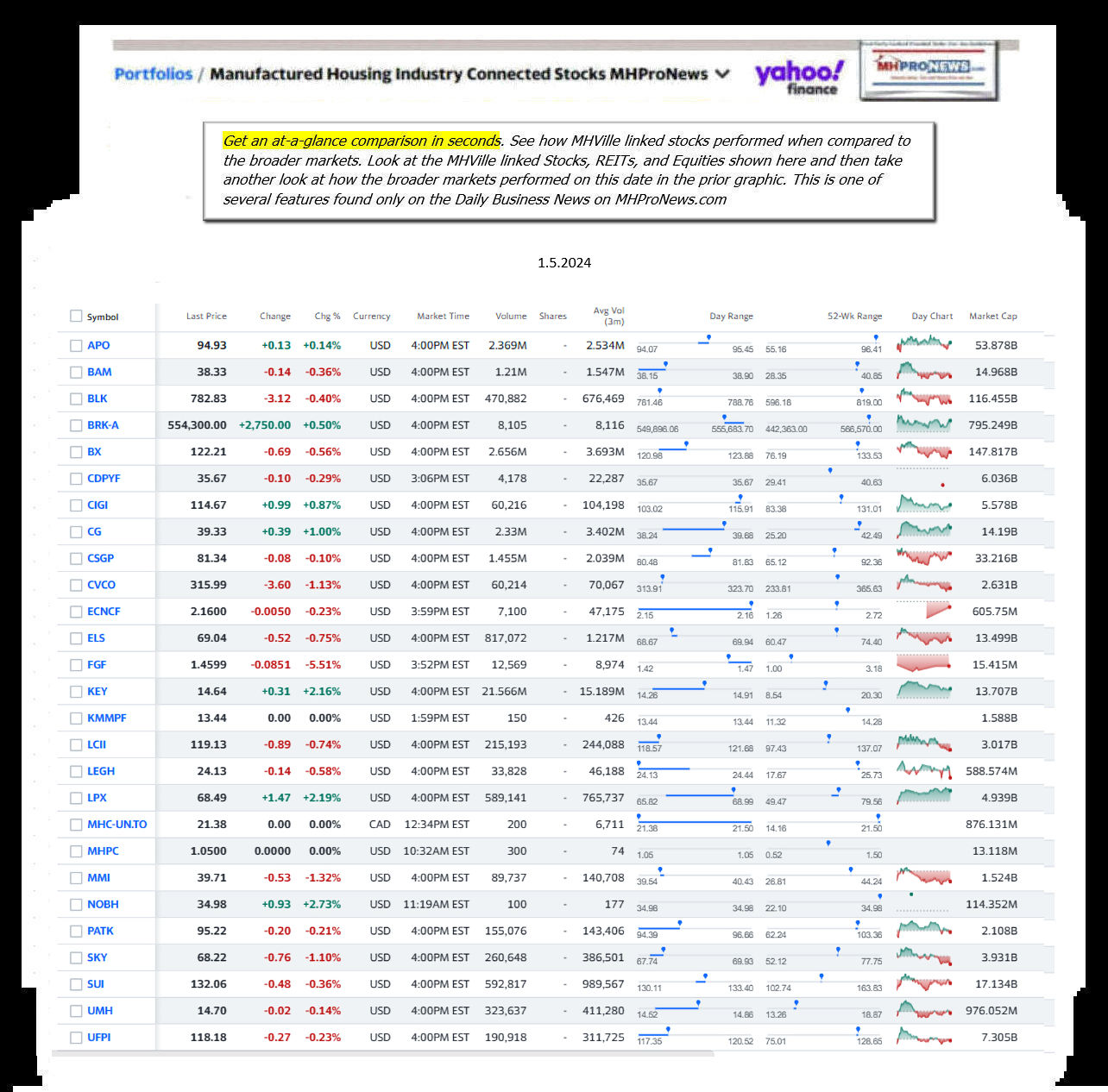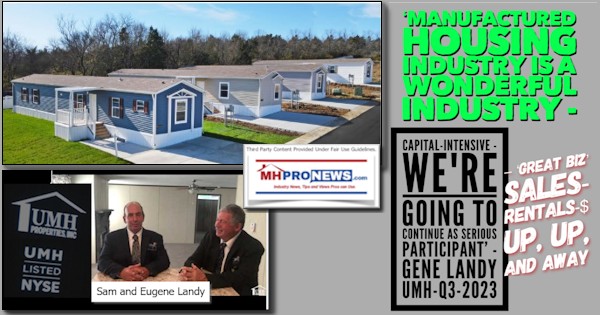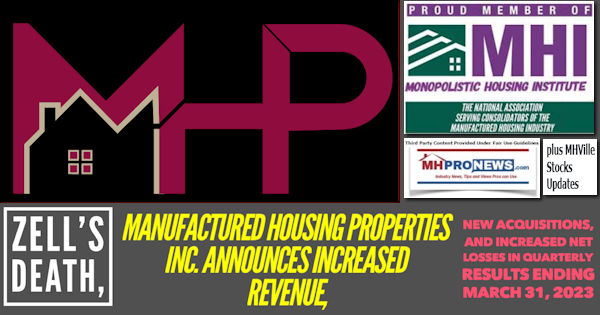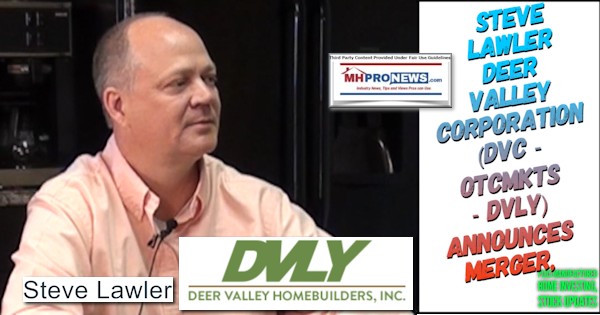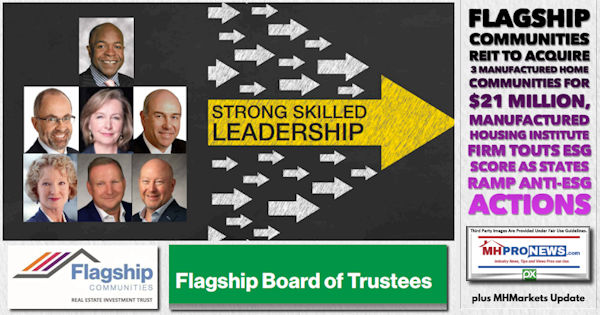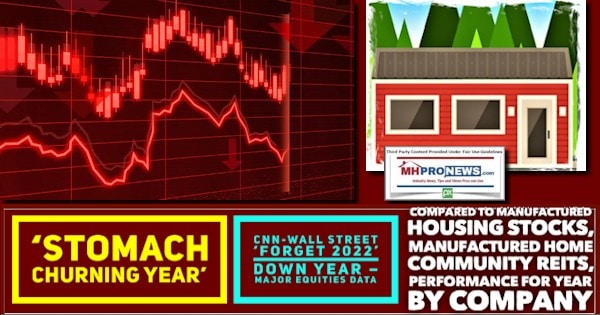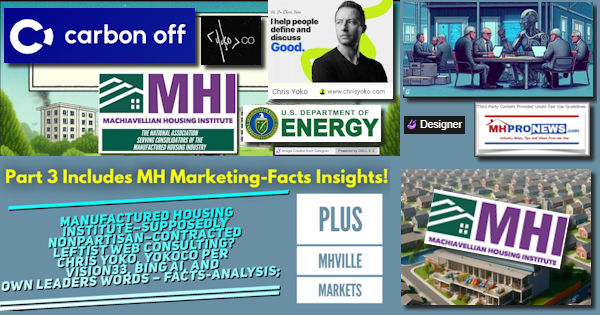
At the base or footer of the Manufactured Housing Institute (MHI) home page is the name of the firm responsible for their website: YokoCo.com. Per Chris Yoko on their website: “Yoko Co is proud to announce that we remain committed to continued carbon neutrality.” “In the interest of transparency and a shameless attempt to increase societal peer pressure, we like to share our carbon emissions data. This year our carbon footprint grew a bit compared to last year, but per capita remained about the same.” Their website says that Chris YoKo is their founder. So, when those remarks about “carbon neutrality” are viewed in the light of the ongoing MHI litigation against the U.S. Department of Energy (DOE), that begs questions. Per Bing AI on this date: “Trade associations are typically nonpartisan or nominally nonpartisan in the sense that they work with members of both major political parties in the U.S.” That being so, and given that MHI asserted under penalties of perjury that their mission is to “expand demand” and “Improve the overall operating environment for the manufactured housing industry,” why did MHI pick YokoCo.com to represent their ‘pro-growth’ trade organization online? Because YokoCo says: “When we say we work with organizations who are driven by a purpose beyond profit, we don’t mean you can’t make money. It just can’t be the only thing that drives you. In fact, we’d love to help you be more profitable by focusing on the impact of your work.” In context, YokoCo and their leaders repeatedly seems to mean “impact” in the environmental sense. As Bing Copilot (Bing AI) said on this date in response to an inquiry about their meaning of impact: “…it is reasonable to assume that they are referring to environmental impact given their focus on reducing carbon emissions and promoting sustainability132.” That and what follows begs several questions and concerns. Aren’t ethical and sustainable profits a legitimate motivation for the manufactured housing industry companies that MHI represents? Indeed, given MHI’s 990s and their home page remarks that they state they want to “expand” and “grow” the manufactured home business. That would be a common expectation for a smaller business that joins or remains a member, that they think on some level that MHI is sincere in saying they want to expand and grow the industry, not only because they say so, but also because that is what associations are expected to do. Those thoughts in mind, recall that Cavco Industries’ CEO William “Bill” Boor – speaking on behalf of MHI – essentially denounced in remarks to Congress the push toward leftist backed ESG principles. So this initial and the next paragraph set up the apparent disconnect between what YokoCo stands for and what MHI claims they stand for in their respective remarks.
To elaborate on Boor’s remarks to Congress on 7.14.2023, and as an FYI for new readers and a reminder to regular visitors at MHProNews, these issues are significant for our profession for a range of reasons. In the U.S. at this time, there is a seemingly expanding ESG related battles underway, as was suggested by Cavco’s CEO (and then MHI’s Vice Chairman, now Chairman) Bill Boor in his remarks to Congress linked here. But this topic is also significant because of the ongoing controversies with respect to the pending implementation of the DOE’s manufactured housing energy rule.

Notice: Part II of this report will have several eye-opening manufactured housing marketing related items that are important, if not “must see” for numbers of manufactured housing industry professionals. That said, back to this introduction and the focus on YokoCo and MHI’s curious relationship.
So, these are relevant and pragmatic concerns.
Those points noted, there are several possible questions with respect to what the MHI selecting the YokoCo organization to do their new website may signal to industry professionals. Of lesser importance to our profession, but perhaps of importance to some seeking insights about YokoCo is the notion that the reverse may be true too. Meaning, is YokoCo.com posturing or serious in their claimed commitments to environmental standards and related issues to their client work? For a range of reasons, carefully documenting what follows from cited sources including their own websites and leaders’ environmental and apparently political remarks.
A look at the information herein developed from stated sources will clarify the issues and concerns. Recall that both MHI and the Manufactured Housing Association for Regulatory Reform (MHARR) – at least on paper – have said that they oppose the DOE energy rule as drafted.
Diving Into Insights About MHI Website Provider – YokoCo
In their about us history segment, the YokoCo website on this date says: “In 2014, we were fortunate enough to be able to make a shift we’d been thinking about for a long time: From that point forward, we would only work with organizations who aimed to make a positive impact on the world.” Several of the firms on their apparent client list appears to be corporations with left-leaning political interests. Given that MHI is supposedly a nonpartisan organization, does the association with YokoCo signal that their politics have tilted left?
Per YokoCo – “We wanted to spend our time working on projects we were passionate about, with clients whose missions inspire us.”
On 1.5.2024 MHProNews reached out by email to ask YokoCo about their politics. A question was emailed to YokoCo.com at Fri, Jan 5, 10:25 AM ET. Over 24 hours later, on 1.6.2024 there has been no reply to an email sent to their firm with this inquiry. Here was the subject and body of the inquiry message.
| date: | Jan 5, 2024, 10:25 AM | ||
| subject: | Just one quick question about your company and services |

“Yoko Co Still Remains Carbon Neutral”
Please advise, thank you.
Tony
##
Normally, a company like that would be swift to reply, because they might think they have a prospect. But for whatever reason(s), they have at this point opted not to reply.
That said, more about Yoko.com from their website and other sources. The MHI website provider’s own website also says: “When we look past the dollar signs, we discover the real metrics that drive action, conversion and change. That’s what we’re about.”
Pardon us, but that is the politics of MHI now, and MHI claims that almost every state association in the U.S. are MHI state affiliates, what does all that mean to professionals who are either a-political, centrists, or right leaning?
In response to inquiries made to Bing’s AI driven Copilot, where these responses, edited down to key points. The initial inquiry is shown, but the others are edited or omitted for length.
>> “What are the online political indicators for Chris Yoko, founder of YokoCo.com? Is he more progressive? Conservative? What?”




Bing apologized for sounding like it is politically biased, and admitted, as is shown above, that 90 percent of Democrats and Democratic-leaning independents “support developing alternative energy sources to address America’s energy supply.”
But in part of a longer thread, Bing Copilot admitted (some of the edited-out remarks) that: “Climate is not the end of the planet. So the planet is going to be fine.” So said William “Bill” Gates III, a well-known ally of Warren Buffett, the leader at Berkshire Hathaway (BRK), which owns several high-profile brands at MHI. Gates reiterated that sentiment at the Times event a few days later. “There are effects on humanity, the planet less so,” Gates said on 9.22.2023, both quotes by Gates cited by left-leaning Fortune.
So, while Bing is technically correct in saying that “not all policies related to sustainability and environmentalism are necessarily aligned with the Democratic party’s platform,” it is also true that per left-leaning Pew research, 90 percent of Democrats and Democratic leaning independents buy into the climate change and related agenda. And as Bing Copilot observed, there are no items that it identified “I could not find any information that suggests that he or his organizations take a more centrist or conservative view on any issue.”
Summing this segment up, it seems likely that YokoCo and company are progressives or leftists in broad alignment with Democratic priorities. To be clear, that is their right. The primary point here is what does this signal to manufactured housing professionals or others as they sift the tea leaves about MHI? What is MHI’s authentic agenda? Because industry growth is an arena that some two decades of data reveals that MHI has done a poor job of achieving. So poor, that for the last 13 straight months, manufactured housing production has declined each month in year over year comparisons of that month to the same month a year prior.
Climate is a big issue in our society and others too. If climate change is actually caused by manmade activity, and if that climate change is actually a risk to humanity, then it obviously should be dealt with.
That said, there are voices on both sides of the climate change debate. Bing Copilot seems to side with those who embrace climate change activism. There are not only good, but strong reasons for thinking people to think that climate change is a political agenda backed by certain business and nonprofits for their own reasons that have little to do with science.
To illustrate, Bing Copilot admitted more than once:



The problem there, which Bing Copilot did not initially address, is that there is no known evidence that the Obamas have taken any steps to mitigate the supposed “risks associated with rising sea levels” on either Obama property.
When pressed, Bing admitted there is no evidence that the Obamas have taken any steps to mitigate against the supposed risks of rising sea levels.

Meaning, even those who claim to believe in the ‘risks’ of ‘manmade climate change’ are not acting in a manner consistent with their claims. With that in mind, it is good again to consider what Bill Boor told Congress last summer on MHI’s behalf.

For government to impose costs or ‘standards’ on citizens and/or businesses that may have a political agenda, as opposed to be grounded in something like common sense or an authentic emergency is an obvious problem. There are constitutional and other issues at play that much of the mainstream media downplays, ignores, or doesn’t generally address. It is one of many reasons why much of the population doesn’t trust the media, because of bias. Bing Copilot de facto acknowledges that in the climate change Q&A.
Note: there are some surveys that indicate that the
trust in mass or mainstream media is lower than this Gallup survey reflects.
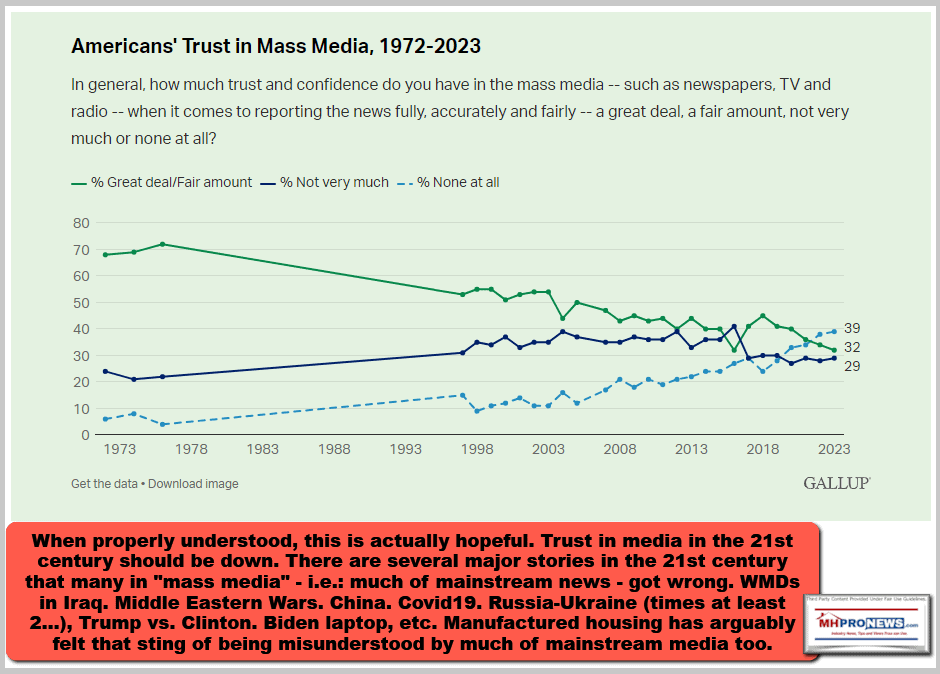
That noted, per the Carbon Off website, which Chris Yoko founded and is associated with YokoCo.com, “Our portfolio of projects also includes a number of co-benefits in addition to the elimination of greenhouse gasses. When and where possible aim to maximize the UN’s 17 Sustainable Development Goals.”
The point is that whatever Yoko may say, or not, about their political bias, it seems that they are ‘all in’ on the climate change, which has a 90 percent alignment with Democratic politics, per Pew as cited by Bing Copilot.
That seems to be out of step with what MHI’s messaging, including remarks made by MHI Chairman Bill Boor has said on related topics.
To further illustrate these topics, is evidence from the following Q&A is with Ray Van Hilst. Hilst, per the YokoCo.com website, is their “Director of Client Results.” This interview below from Vision 33 appears to have been posted in 2021.
MHI Could or Should Have Known These Things Before MHI Selected YokoCo As Their Web Consulting/Provider
So, along with much of what is shown herein, MHI could have readily done a simple web search and learned the same sorts of things that this report and analysis is revealing. Presumably, MHI leaders would have made such an inquiry. Ellipsis […] below indicates items edited out that are less relevant to our readers. For the full interview, click here. Note that yellow highlighting is not only added on the environmental or advocacy topics, but some others that in the analysis and views of MHProNews may be of interest to industry professionals.
Part I
…
Ray Van Hilst: Thank you for having me, Carl. Yoko Co. is a digital marketing agency. We work exclusively with organizations making an impact in the world with a motive beyond profit – nonprofits, associations, and for-profit companies doing game-changing technology/work. Companies that are motivated to make this world better. We believe an organization’s website is their biggest lever for making a positive impact, so we help them maximize their web presence. I’m the director of Client Results. I help clients move from “Wouldn’t it be great if …” to planning a content strategy to make it happen.
Carl Lewis: Your website says it was over a decade ago that Yoko Co. decided to work with only those types of businesses. What prompted that decision?
Ray Van Hilst: Chris Yoko, the CEO, and the team asked, “What kind of work energizes us? What makes us excited?” Nothing against people building or selling widgets, but is that fulfilling? They looked at the clients who care as much as we do. And we found that the clients who see the end benefit of their jobs are the most passionate and go “all in.”
That’s one of our rules of engagement: go all in or leave. We care passionately about helping our clients do better in the world, and we need them to care passionately about their work too. We work for eight to 10 hours a day – let’s make sure we enjoy it and feel positive.
Carl Lewis: That appeals to me because I worked at two nonprofits. One was religious; one was a medical relief agency. I thought it would be fun to discuss how these businesses have had to change in the last year and a half. Their change differed from, say, a distribution company. What have your customers cared about differently since the pandemic?
Ray Van Hilst: When the pandemic kicked in, there was a sense of panic and collapse. Everything contracted, and people stopped spending – especially in nonprofits that should be spending their money on their outcomes and helping people rather than on marketing projects with us. And we understand. But then people realized COVID-19 wasn’t a short-term thing, and they needed to adjust.
One thing we saw was that the organizations with the most agile technology and mindset pivoted faster. And if they were willing to experiment, they got ahead of the curve. For example, we saw traffic decrease across many of our client sites, but web traffic for associations that handle continuing education increased.
People were saying, “I still have to get continuing education for my job. And I’m not at work, but I can do it from home. It’s even more convenient – I can do it on my own schedule.” That’s an example of using your content to respond to needs as things changed.
Carl Lewis: When there was an economic downturn during my time at the nonprofits, we found that our competitors were always competing for the donation dollars to continue what we were doing. They would shrink their programs and have fewer fundraising events. But I oversaw fundraising at my organization and decided downturns are opportunities to step up. That seems like what you’re saying. And we found that when the economy drew down, we could still grow – with the right mindset and if we did more than before.
Ray Van Hilst: Yes. Our clients also saw opportunities to stop doing things. When business is good, we start special projects, but when things get tighter, we ask, “Was this the right thing to do?”
Carl Lewis: What did people change about their websites as quickly as possible to adapt to COVID?
Ray Van Hilst: There were several areas of identifying immediate content. For example, one client is the American Association of Endodontists (AAE). People still needed root canals, but there was a lot of concern about the safety of going to the dentist.
So, there was a period of, “How do we react?” But now, the AAE has a patient site explaining what people need to know about getting root canals during a pandemic. It goes back to content strategy 101: Address what people are worried about and make that content front and center. The AAE did a great job. And as things open back up, we can prioritize other content.
Also, people were stepping up their search engine optimization (SEO) game, and search traffic jumped as people were online more. The question is, “Does your site have the content to address people’s questions?” If not, creating that content and adding a user journey to confer off it are crucial.
Carl Lewis: Some reports said that internet traffic increased dramatically in the last year. How did that play into what people realized they needed to do?
Ray Van Hilst: One trend was that traffic across all our sites dropped slightly throughout the pandemic as gross numbers, but engagement went up. It’s because the tire kickers weren’t coming as often – the people coming were more focused and looked at more pages. With all the sites we manage, those with defined user journeys saw more conversions and opportunities to engage.
The other trend is the importance of SEO. We’ve seen traffic go up via organic search, particularly in this pandemic, and there were at least two major Google search engine algorithm updates. That will change things. But if you’re offering helpful content, you’ll always win in this game. You can’t keep up with Google’s algorithm changes. That’s a game of Whack-a-Mole. But you can have authentic, helpful content that speaks to your audience and helps them succeed. Google will always reward that content, and your traffic will go up.
Carl Lewis: Let’s talk about content. In my organization, we work hard to create new content constantly because no matter how good/relevant your content is, the algorithms want new stuff. And there’s a premium to pay for that. How big a challenge is it for your clients to constantly answer the same questions in new ways with new content?
Ray Van Hilst: The first thing organizations struggle with is figuring out which questions to answer, what content to create, and how to align that with their strategy. We have one client with a fabulous blog program. I asked, “Where do you get the content?” The CEO said, “I write about my ideas.” And I said, “There’s a place for that, but you have to ask if it’s content related to something your users are trying to solve or interested in.” Because otherwise, it won’t help your SEO.
When someone comes to your website, they’re not coming to learn about you. They have a problem. It’s our job as marketers to say, “Here’s your challenge – let me help you solve it. Here’s some information for you.” That’s how you can keep that pipeline fresh. Your other opportunity is evergreen content. You can create a landing page about a subject on your site, and Google’s okay if you update it. Add information, make it more relevant, and resubmit it to Google. That’s your pillar page for a core concept, and then you have other pages to support it, like blogs that link back in.
Carl Lewis: I used to work for a CEO at a small consulting firm. He read a book every weekend, and then at our all-hands meetings on Mondays, he told us about the book he read. No other agenda. It’s like, “Where are we going with this?” There wasn’t a theme. And I can see how that’s easy for a CEO because many are well-read and have a lot on their minds. They like to share it. But doing it strategically, like, “Which questions do people need answers to?” is more important. The challenge is doing it in a new, fresh way.
Ray Van Hilst: Yes. And there’s a place for that thought leadership and pushing what you do forward, but that should be 30%-40% of your content. You still have to cover the base. You can write the best book in the world, but it won’t be a New York Times bestseller or change the world if no one ever reads it.
Carl Lewis: Companies typically know what they do and believe, but many struggle to discover what customers want them to talk about. They can be on a different page, which leads to their website’s content not being 100% relevant to their customers and prospects.
Ray Van Hilst: It’s classic. If you go into most SaaS companies and ask them what content they need, the salespeople will have many ideas because they talk to the customers. Customer relations and support will also have ideas. Marketing will say, “But this is our branding message. It’s going in with that.”
Carl Lewis: Exactly. It’s difficult to answer customers’ questions because we get bogged down by what we want to tell them versus giving them the answer they want. And when they’re looking for answers, they’re only on your site because the search engine told them you might have answers. They don’t even know you in the prospecting stage; they’re just looking. And creating content that’s relevant to the people you want it to be relevant to is challenging.
Ray Van Hilst: There are two things you can do. One, you can go outside your building and talk to customers with an open mind and be ready to hear things you may not want to hear. Don’t talk to the customers you always hear from – the frequent flyers you know and those who give you most of your revenue. Dig deeper and talk to casual buyers and infrequent users about the journey of what they were looking for.
Next, map your content toward their understanding of what you do. We use a methodology we call the conversation spectrum. It’s how someone goes through content. The stages are oblivious, curious, intrigued, invested, and converted. It’s a variation of awareness, knowledge, liking, and preference we learned in college marketing. But to people, it’s, “I have a problem to solve.” As you said, they don’t even know you exist. They just googled. Hopefully, they get to your website and say, “Here’s an answer!” That’s a way to manage the conversation and not overwhelm someone through your website journey.
Carl Lewis: Yes. Because the search engine just takes you to the landing page, which isn’t actually your page. They bypassed who you are, what you do, how you do it. You’re trying to build a relationship by providing value.
Ray Van Hilst: The sad part is that the landing page is something someone put up in a hurry. Think about the website design process. We have five meetings about the homepage, then it’s, “Okay, we’re good. Move on. Build the other 400 pages.” We don’t consider that the homepage is rarely the first thing someone sees. What’s the call to action? What’s the next step? Does this page look as good, and does it work as hard, as the homepage?
Carl Lewis: And as you said, landing pages must be refreshed occasionally. My company’s growth makes me think we do a good job with marketing. Our sales guys would say it’s all them, but our marketing department assists with that endeavor and the website. We remake ourselves every two or three years. The information isn’t significantly different, but it’s refreshed. It has a different look. It’s organized better.
Ray Van Hilst: That’s important. Marketers – and budgeting for marketing – must be aware it’s no longer ‘set it and forget it.’ Your website needs constant investment. We tell our clients they should budget 20% to 30% of their budget for maintenance and ongoing improvements after they finish the first project.
Define your KPIs, test, improve, repeat. Keep making modifications as you do that. Financially, many organizations say, “We’re going to spend a ton of money on the website. We’re going to amortize this over five years and not spend any more money.” Five years later, they wake up and realize the website is ugly and doesn’t work anymore. Had they spread that cost out, five years later it would still be an attractive website that’s meeting their goals.
Carl Lewis: A lot of smaller organizations struggle to put money in their marketing budget. Because the outcomes can be nebulous – especially without tracking mechanisms to see the results of that investment. And many companies don’t have those. How can they recognize the value of investing in marketing?
Ray Van Hilst: Define your goals and KPIs. What do you want to do? How do you define success? We do this in our kickoff meetings. We say, “What does qualifiable success look like at launch and six months later? What about quantifiable success?” More leads? More donations? If it’s our animal welfare client, maybe it’s more adoptions. The challenge is that your teams are busy. And organizations – especially nonprofits – don’t often put someone in charge of the website.
But a website needs an owner. A managing editor within your organization. A content strategy. A governance strategy that says, “Jane is the managing editor, and she’s going to decide this, our content cadences, our roles.” Etc. That’s her primary role. Many organizations say, “Marketing director, you’re in charge of my user conference, email campaigns, and social – oh and by the way, the website.”
Put someone in charge. Include analytics. We offer our clients analytics support because we look at trends across every site we build, host, and manage. We can offer insight into where you look good and where you need to improve.
Carl Lewis: We’re a nation of small businesses. As a country, we probably have more nonprofit types of companies than anywhere in the world. Now that we’ve gone through this weird time, do you think any big lessons will help us going forward?
Ray Van Hilst: One: Embrace the concept of ‘digital first.’ Your digital strategy can lead the way to get your message out and engage your audience. A friend owns a coffee shop here in Northern Virginia. He said, “I need a website.” I said, “You haven’t even started roasting coffee.” He said, “I need a website first.” And he got it. He now has three locations, and he’s doing awesome. Always keep that ‘digital first’ attitude.
Two: Don’t get stuck on shiny objects. The shiny object syndrome is real. We work in WordPress, but you might look at a larger system. You may need Sitecore. Or HubSpot. It’s okay to start small. I’ve helped people get set up on Squarespace and Weebly. They work. Get your training wheels on the tools you can use, then grow into the next thing. It’s like the bikes we were talking about before we started recording. Don’t buy a $12,000 carbon fiber bike if you’ve just started cycling.
Carl Lewis: I started with a Yamaha 125s. I think it was a Suzuki 185. Then I went back to a Yamaha 450, and that one hurt me. Same principle.
Ray Van Hilst: It’s natural. I read a study about how people overbuy in their marketing technology. They aspire to it, but they don’t have the bandwidth for it. And the good thing is, most tools you can easily migrate. I try not to encourage clients to go all in on one particular tech stack because it creates more work if they have to move. But look at ways you can plug and play and grow in different places within your marketing technology. … ##
Part II – Additional Information with More MHProNews Analysis and Commentary
1) Let’s first disclose that MHProNews parent company also does website building, design, and maintenance along with other marketing, training, and sales-driving services.
2) That said, MHProNews has for some years explored the macro environment that manufactured housing is operating in as well as the more specific realms of housing, affordable housing, and manufactured housing. While that was a conscious decision on the part of our publications’ leadership, it has also increasingly served the manufactured housing profession well. There is a body of facts, research, third-party and internally generated evidence and analysis found on MHProNews/MHLivingNews that are simply unlike anything else available online in manufactured housing. Several issues addressed here may be address, for example, by the Manufactured Housing Association for Regulatory Reform (MHARR). But other issues are per search results using Bing Copilot and/or Google are found largely or only on MHProNews/MHLivingNews and nowhere else in MHVille. Hold this and Part II #1 above in mind. Then, let’s use some pull quotes from the above to see what it should tell us about MHI.
3) Per the Q&A with YokoCo’s Ray Van Hilst “Director of Client Results” are the following. While we may see some issues differently, like the need to work with people who seem to believe in climate change. To contrast, Hilst said: “We work exclusively with organizations making an impact in the world with a motive beyond profit – nonprofits, associations…” That reflects YokoCo’s view. In our view, so long as something isn’t illegal or unethical, someone’s politics or other beliefs are obviously part of an individual’s God-given rights and are supposed to be reasonably protected by being an American. In our consulting practice, would not be interested in working with a firm or organization that aims to mislead or manipulate parts of their target audience, for example.
Manufactured Housing Marketing Related Topics
That clearly stated, several of the more marketing and website specific points Hilst made are arguably common sense and quite appropriate. YokoCo, in working with MHI, has taken on a client with an arguably legally and morally problematic 21st century history. That noted, MHProNews will next examine some of those remarks by Hilst to see what light they may reveal about MHI and their behavior. In so doing, it may also help those who are considering their own website’s content to better grasp their own strategies.
4) Per YokoCo’s Director of Client Results Hilst: during COVID19: “we saw traffic decrease across many of our client sites, but web traffic for associations that handle continuing education increased.” MHProNews has for years hammered away at the point that MHI has failed to implement their own Roper Research results. MHI talks about education, and they have members that present on ‘educational’ topics. Perhaps some of it is relevant. But the facts remain, that manufactured housing is underperforming during an affordable housing crisis. While MHI’s traffic, per SimilarWeb, may be up nominally, it is still poor engagement. Who says? It is the implication of Hilst’s remarks:
a) traffic across all our sites dropped slightly throughout the pandemic as gross numbers, but engagement went up.
b) we saw traffic decrease across many of our client sites, but web traffic for associations that handle continuing education increased.
c) people coming were more focused and looked at more pages.
Note that use of words: “pages.” According to SimilarWeb, MHI visitors for some time barely visited a single page. This is not what YokoCo says they want to see, but it is what MHI has reportedly experienced, again per SimilarWeb.
In several devices, you can click the image below to open in a larger size.
While devices vary, click to download and open, or click and follow prompt options.

5) MHI’s website traffic, since YokoCo apparently began working with MHI in their late summer 2023 website refresh has apparently declined, per data from SimilarWeb.
However, pageviews per visit are up, also per Similar Web. See details in this screen capture collage, above.
- Clayton Homes is reportedly selling about 1/2 of all new HUD Code manufactured homes. So, if manufactured housing ends the year about 90,000 (+/-), their traffic data per SimilarWeb suggests that statistically only 0.02 percent of all their visitors buy a Clayton built manufactured home. A mere fraction of 1/2 of 1 percent of their visitors. That does not seem very impressive, does it? Given how much Clayton invests in marketing?
- It would seem there is a serious difference between what SimilarWeb and MHV reports on MHV traffic. Has MHV inflated their traffic by more than 30 percent? 4.517×4=18.068M vs. 25M they claim.
- On this date, 1.6.2024, MHVillage delivered an email that stated in part the following, that they are: “the nation’s #1 website for manufactured housing with over 25 million unique annual website visits.”
- But on this date, per SimilarWeb the Zillow.com website reports that in the last quarter, they had 875.2M visit. Zillow offers manufactured homes as well as conventional housing and land.
- On the one hand, as a listing site retailing new manufactured home for sale to the general public, that claim that MHVillage (MHV) are the nation’s number one website for manufactured housing. That may be true in some specific or narrow sense. But again, when the conversion ratios are considered, they are converting a sliver of a faction of a percent.
- Also of interest. The 4.517 million visits reported by SimilarWeb for MHVillage dwarfs ManufacturedHomes.com, which per SimilarWeb in the same quarter shown above had 502,654 visits.
6. It is an apples and oranges comparison. MHProNews is news, tips, and views website, as is clearly stated in the top left of virtually every page as the tag line under our logo. We are not manufactured homes for sale or rental listing site. The sales and rentals sites such as ManufacturedHomes.com and MHVillage ought to be getting, one might think, far more traffic and pageviews per visitor than MHProNews. Our audience is more focused, theirs are broader. Nevertheless, per preliminary data per Webalizer 2.23 and from just 2 of the over 1 dozen severs, MHProNews reported 2,044,938 visitors in 2023.
There were over 14,659,050 pageviews in 2023 on MHProNews, for those same 2 servers per Webalizer 2.23.
Traffic is up significantly over 2022, and it appears that so are total pageviews too.
Perhaps because of an large increase in traffic (visitors), engagement per visitor is down somewhat from 2022. But engagement per visitor is still at a healthy 7.16845694099 pages per visit. That’s roughly double the pageviews per visitor of mass or mainstream news sites such as CNN or Fox.
Restated, our audience apparently is by comparison large, loyal and finds the content very relevant. Our MHProNews audience dwarfs MHIs, which has far more staff and many times our budget. Our audience apparently rivals or beats that of ManufacturedHomes.com, even though they are in the business of marketing and selling homes, and our focus is news for professionals. They ought to have a much bigger audience, yet they do not.
While MHVillage and Clayton have more visitors, they should. They are appealing to the widest possible audience. The home buying public, or the affordable home, and manufactured home buying public. Yet they are producing relatively tepid results – perhaps even embarrassing to some – results. Is it any wonder that manufactured housing is in a 21st century downturn?
In several devices, you can click the image below to open in a larger size.
While devices vary, click to download and open, or click and follow prompt options.
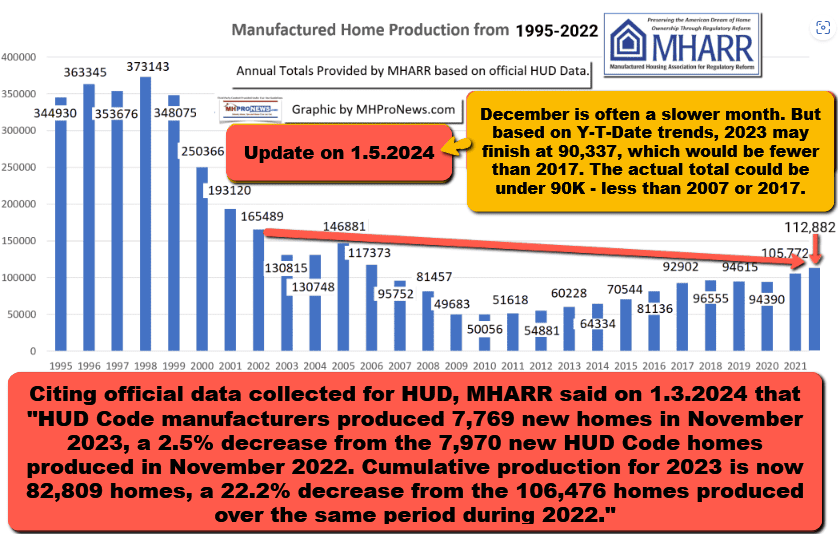
Pivoting Back to More of an Analysis of MHI’s Content, Based on Remarks by YokoCo’s Hilst
7. Consider the following quoted statements from YokoCo’s Hilst, from the interview shown in Part I above.
In no particular order of importance are the following remarks, per YokoCo’s Hilst.
- a) The question is, “Does your site have the content to address people’s questions?”
- b) Define your KPIs, test, improve, repeat.
- c) When someone comes to your website, they’re not coming to learn about you. They have a problem. It’s our job as marketers to say, “Here’s your challenge – let me help you solve it. Here’s some information for you.”
- d) But a website needs an owner. A managing editor within your organization. A content strategy.
- e) the homepage is rarely the first thing someone sees. What’s the call to action?
- f) Marketers – and budgeting for marketing – must be aware it’s no longer ‘set it and forget it.’ Your website needs constant investment.
MHI’s “call to action” appears to be more members, based on how often the message of “Become a member!” appears on their various pages. More members can mean more possible opportunities for consolidation.
8. Another KPI (“key performance indicator”) or desired outcome for MHI appears to be to get members and others to an MHI event. Those events are routinely for a fee. Based on the notion that MHI’s consolidators want a place where they can meet with, ‘network,’ and possible set the direction for a future acquisition, from that perspective, getting people to a meeting makes sense. As has been previously noted and reported, prominent MHI member Flagship Communities doesn’t hide the fact that they want to get opportunities to buy communities off market. That has been part of their pitch to Flagship’s investors. Flagship’s co-founders include Nathan Smith, a prior MHI chairman and still an MHI board member, per their website.
In several devices, you can click the image below to open in a larger size.
While devices vary, click to download and open, or click and follow prompt options.
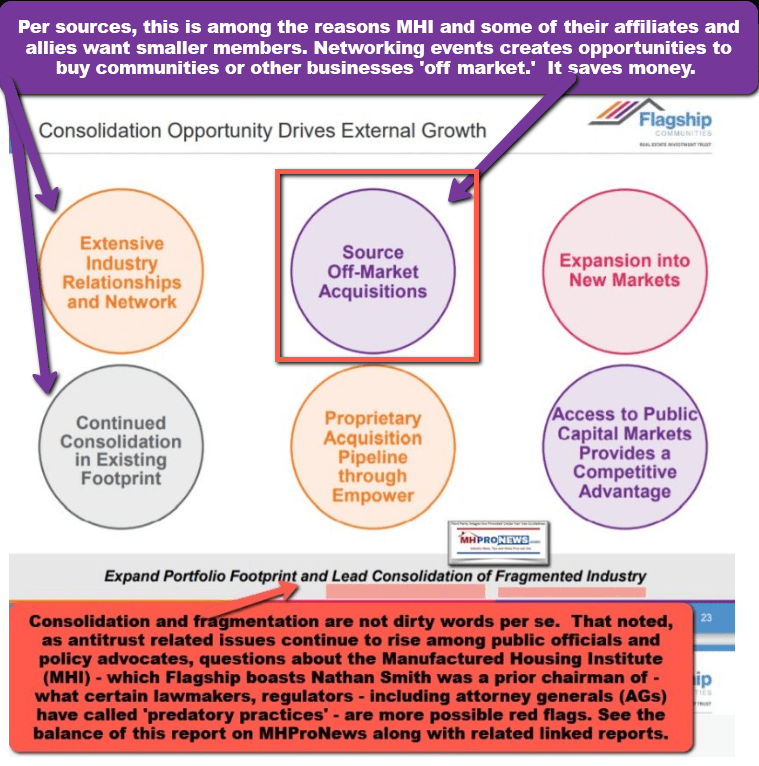
9. But as noted in the above, the problems with these approaches, from the vantagepoint of possible and existing MHI members is that this appears to be a deceptive and misleading pitch by MHI. Is that what YokoCo says they want as their client? And in what ways can MHI demonstrated with actual production metrics that their implemented since YokoCo became their service provider that what they are doing is indeed: “Elevating Housing Innovation; Expanding Attainable Homeownership.” At best, some of these remarks on the MHI website appear to demonstrably be paltering. At worst, they are what Samuel Strommen and others – often outsiders looking into manufactured housing – have alleged are examples of a scheme to monopolize the industry through underperformance.
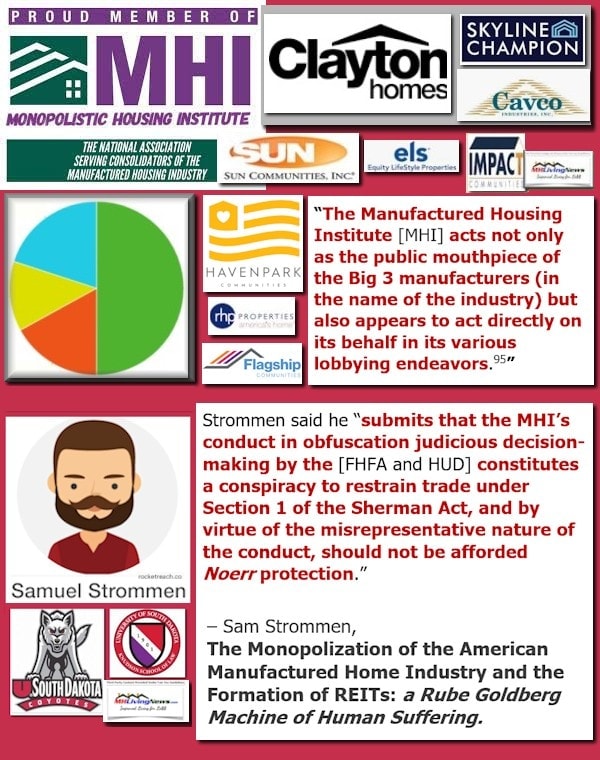
10. In as much as this appears to be part of an ongoing scheme, this may be additional evidence for new litigation, perhaps somewhat akin to the national class action antitrust litigation that has been launched against several MHI members.


11. MHI’s consolidators are facing litigation, as the first article below #10 above reflects. A careful look at those various lawsuits pleadings and our analysis of them reveals that MHI and/or MHI linked state associations may become embroiled in those and/or other suits. Given that a key MHI member and a prior MHI chairman had a significant fall from grace as a result of an SEC probe in the last 5 years, it begs questions.
Should YokoCo respond to our inquiries, MHProNews would plan a follow up report based on the relevance of their remarks and willingness to respond to follow up questions. If MHI opts to respond to this report and analysis, that too could be part of a follow up. MHProNews has issued MHI, several of their corporate leaders, and their attorneys the opportunity to respond to any of our reports. So far, more silence.
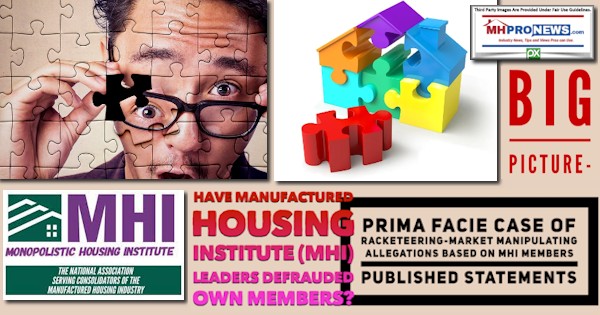
12. YokoCo’s Hilst said that people come to a website are often facing a problem and are looking for answers or solutions. That is a fascinating and often true point. Here on MHProNews, we have ‘tested, improved, and repeated’ our evolving system of reporting. Our articles are far longer than most in mainstream media and are certainly longer than most in MHVille trade media and/or bloggers. It was not always so on MHProNews, which began with USA Today style mini-news briefs. MHProNews eventually moved to somewhat more details articles. Finally, in recent years, we have published more detailed facts and analysis that surprising to some have kept and grown an audience that appears to hunger for the insights and information provided here.
If MHI would get off their high horse and actually deliver on their statements under penalties of perjury, various claims, and promises, America would likely be witnessing a boom in affordable housing access.

But that is not what the data shows. Instead, manufactured housing – under MHI 2.0 “leadership” – has crashed to production levels that the association’s first 21st century president and CEO would not have anticipated, at least per his remarks to The Wall Street Transcript (TWST).
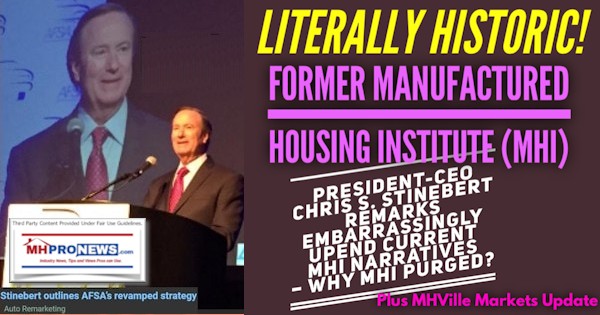
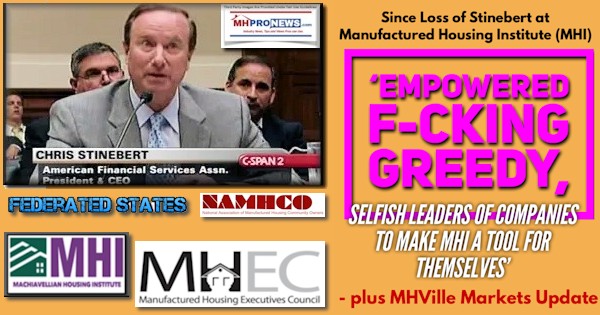
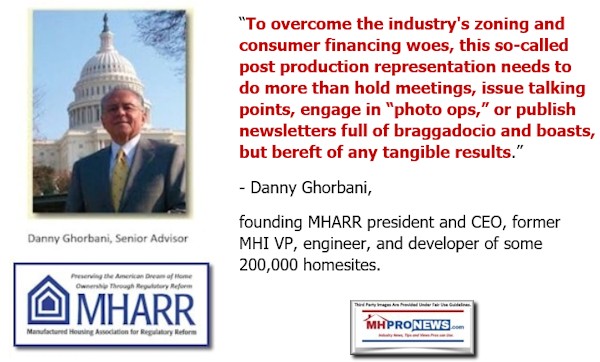

13. Hilst said: “One, you can go outside your building and talk to customers with an open mind and be ready to hear things you may not want to hear. Don’t talk to the customers you always hear from – the frequent flyers you know and those who give you most of your revenue. Dig deeper and talk to casual buyers and infrequent users about the journey of what they were looking for.” If MHI were listening to that type of advice, then one might presume that MHI would not feel the need to attempt to silence or control the messaging from their critics.

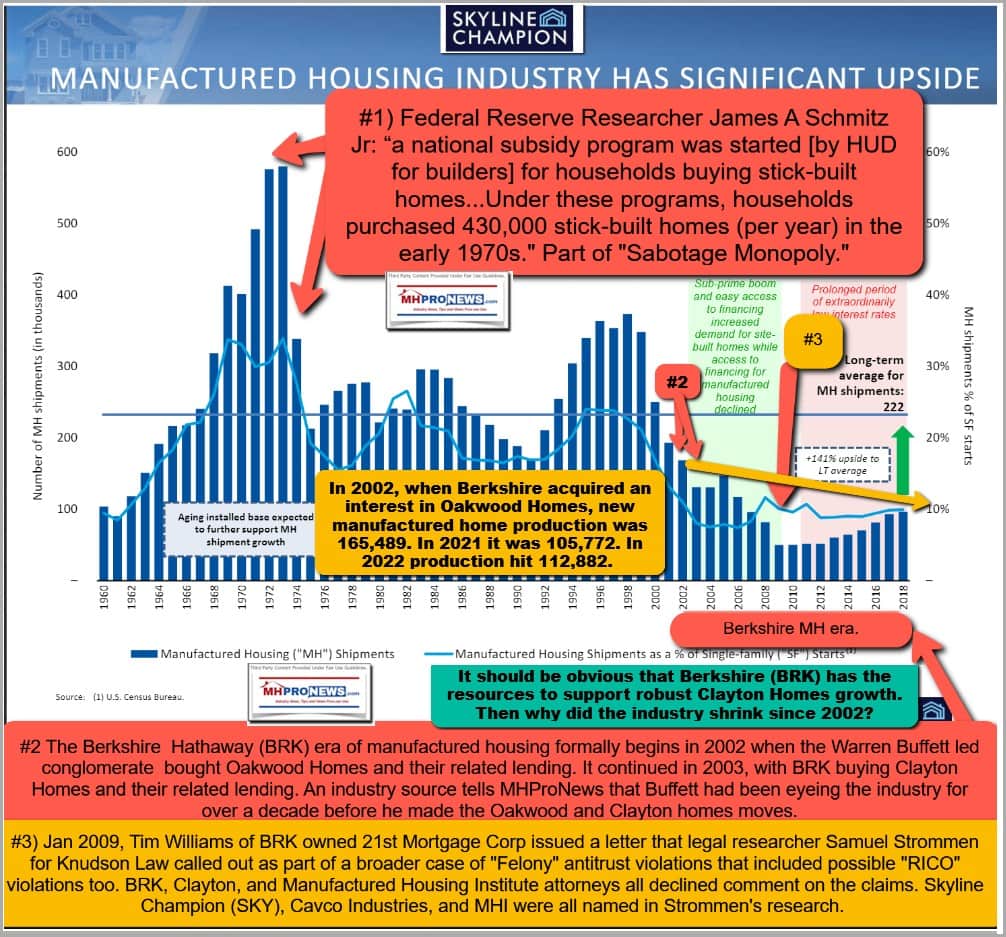
Programming Notice. Initial updates to this report were completed at about 4:41 PM ET, roughly one hour and 15 minutes after the temporary initial report was published. Please check back for possible edits on the above. Thank you.
Part III – is our Daily Business News on MHProNews stock market recap which features our business-daily at-a-glance update of over 2 dozen manufactured housing industry stocks.
This segment of the Daily Business News on MHProNews is the recap of yesterday evening’s market report, so that investors can see at glance the type of topics may have influenced other investors. Thus, our format includes our signature left (CNN Business) and right (Newsmax) ‘market moving’ headlines.
The macro market move graphics below provide context and comparisons for those invested in or tracking manufactured housing connected equities. Meaning, you can see ‘at a glance’ how manufactured housing connected firms do compared to other segments of the broader equities market.
In minutes a day readers can get a good sense of significant or major events while keeping up with the trends that are impacting manufactured housing connected investing.
Reminder: several of the graphics on MHProNews can be opened into a larger size. For instance: click the image and follow the prompts in your browser or device to OPEN In a New Window. Then, in several browsers/devices you can click the image and increase the size. Use the ‘x out’ (close window) escape or back key to return.
Headlines from left-of-center CNN Business – from 1.5.2024
- Third batch of Jeffrey Epstein documents unsealed
- Google illegally refused to bargain with YouTube workers union, says federal labor board
- Brand new Hyundai Santa Fe SUVs are displayed at a Hyundai dealership on April 7, 2017 in Colma, California.
- Hyundai and Kia thefts soar more than 1,000% since 2020
- People walk past the New York Stock Exchange (NYSE) on Wall Street on August 1, 2023 in New York City.
- Markets head for losing week after red-hot jobs report
- Ramanan Raghavendran was named chair of Penn Board of Trustees on January 4, 2024.
- UPenn taps venture capitalist Ramanan Raghavendran to lead board of trustees
- The Snapchat application on a smartphone arranged in Hastings-on-Hudson, New York, US, on Wednesday, Feb. 1, 2023.
- California judge rules Snap must face lawsuit over children’s fentanyl purchases
- A Verizon store in New York, US, on Friday, Jan. 20, 2023. Verizon Communications Inc. is schedule to release earnings figures on January 24.
- How to claim your slice of a $100 million Verizon settlement
- Jobseekers attend the Civil Service Career Fair hosted by the office of State Senator Robert Jackson at the Bronx Community College in the Bronx borough of New York, US, on Tuesday, Dec. 19, 2023.
- The US just capped off another banner year of job growth. Now it’s at a turning point
- HAIKOU, CHINA – DECEMBER 17: People purchase brandies during the 26th China (Hainan) International Winter Trade Fair for Tropical Agricultural Products at Hainan International Convention And Exhibition Center on December 17, 2023 in Haikou, Hainan Province of China.
- China and Europe’s trade spat escalates as Beijing targets French brandy
- Sam Altman, chief executive officer of OpenAI, at the Hope Global Forums annual meeting in Atlanta, Georgia, US, on Monday, Dec. 11, 2023. The meeting includes over 5,200 delegates representing 40 countries aiming to reimagine the global economy so the benefits and opportunities of free enterprise are extended to everyone.
- OpenAI CEO says Muslim tech workers fear retaliation for speaking out
- Houthi attacks close vital Red Sea route for Maersk’s container ships
- Bill Ackman’s wife is accused of plagiarizing part of her dissertation
- Chinese shadow bank Zhongzhi files for bankrupcty
- Tesla recalls 1.6 million cars in China to reduce risk of collisions
- Rose-hued Stanley cups for Valentine’s Day spark a frenzy at Target
- NLRB complaint alleges Lucid fired employees for union effort
- Three years after the January 6 attack, propaganda about the insurrection is poisoning the American public
- What Wall Street got wrong about 2023
- ‘Disheartening and ill-founded:’ McDonald’s CEO responds to Middle East backlash
- Pepsi and Lay’s pulled from supermarkets in Europe over price increases
- Inflation isn’t beaten yet. Price rises are accelerating again in Europe
- His fortune shrank by $80 billion last year. Now India’s Gautam Adani is back as Asia’s richest man
- In newly unsealed court documents, a detective describes recruitment of dozens of girls for Epstein
